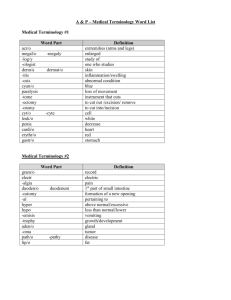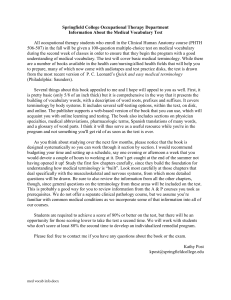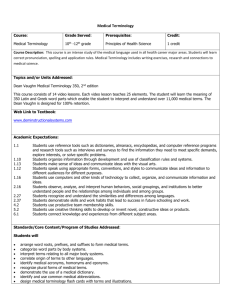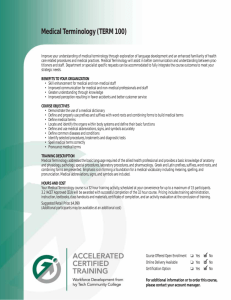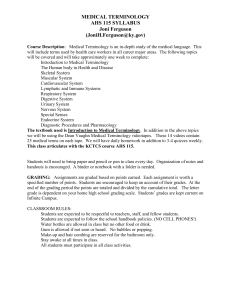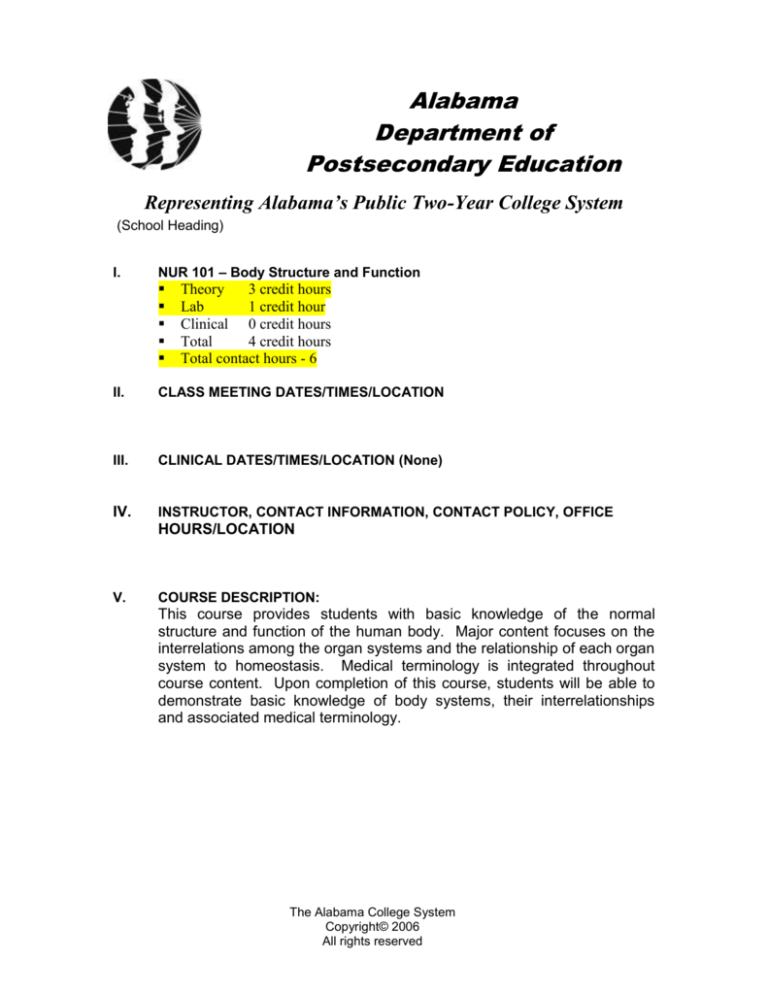
Alabama
Department of
Postsecondary Education
Representing Alabama’s Public Two-Year College System
(School Heading)
I.
NUR 101 – Body Structure and Function
Theory
3 credit hours
Lab
1 credit hour
Clinical 0 credit hours
Total
4 credit hours
Total contact hours - 6
II.
CLASS MEETING DATES/TIMES/LOCATION
III.
CLINICAL DATES/TIMES/LOCATION (None)
IV.
INSTRUCTOR, CONTACT INFORMATION, CONTACT POLICY, OFFICE
HOURS/LOCATION
V.
COURSE DESCRIPTION:
This course provides students with basic knowledge of the normal
structure and function of the human body. Major content focuses on the
interrelations among the organ systems and the relationship of each organ
system to homeostasis. Medical terminology is integrated throughout
course content. Upon completion of this course, students will be able to
demonstrate basic knowledge of body systems, their interrelationships
and associated medical terminology.
The Alabama College System
Copyright© 2006
All rights reserved
Body Structure and Function
VI.
PREREQUISITE(S)/CO-REQUISITE(S)
PREREQUISITE COURSES
None
CO-REQUISITE COURSES
None
VII.
TEXTBOOK(S) AND OTHER LEARNING RESOURCES
ACS Copyright© 2006
All rights reserved
NUR 101
Body Structure and Function
VIII.
NUR 101
PROFESSIONAL COMPETENCIES/OBJECTIVES
Explain structure and function of the body
MODULE A – BODY STRUCTURE AND FUNCTION
A1.1.1 Define terms associated with the structure and function of the body.
A1.1.2 List organizational levels of the body in order of increasing
complexity.
A1.1.3 Explain anatomical position.
A1.1.4 List anatomical directions.
A1.1.5 Explain anatomical directions.
A1.1.6 Explain the relationship of anatomical directional terms to the body.
A1.1.7 Identify planes or body sections.
A1.1.8 Explain planes or body sections.
A1.1.9 Identify body cavities and subdivisions of each.
A1.1.10 Identify body regions and subdivisions of each.
A1.1.11 Explain mechanisms to maintain homeostasis.
A1.1.12 Relate medical terminology to the structure and function of the body.
MODULE B – CHEMISTRY OF LIFE
B1.1.1 Define terms associated with the levels of chemical organization.
B1.1.2 Identify three kinds of particles within an atom.
B1.1.3 Differentiate between ionic bonds and covalent bonds.
B1.1.4 Differentiate between organic and inorganic compounds.
B1.1.5 Explain the difference between solvent and solute.
B1.1.6 Explain the concept of pH.
B1.1.7 Explain the difference between acid and base.
B1.1.8 Explain the structure and function of carbohydrates, proteins, lipids,
and nucleic acids.
B1.1.9 Relate medical terminology to chemistry of life.
MODULE C– CELLS AND TISSUES
C.1.1.1 Define terms associated with cells and tissues.
C.1.1.2 Identify the parts of a cell.
C.1.1.3 Explain the structure and functions of organelles.
C.1.1.4 Identify the processes that move substances through cell
membranes.
C.1.1.5 Compare the passive and active transport processes.
C.1.1.6 Explain the flow of fluids through the cell membrane.
C.1.1.7 Explain factors that affect tonicity.
C.1.1.8 Explain cellular reproduction.
C.1.1.9 Identify types of tissues.
MODULE D – INTRODUCTION TO ORGAN SYSTEMS
D1.1.1 List the major organ systems.
D1.1.2 Explain the structure of each system.
D1.1.3 Explain the function of each system.
D1.1.4 Relate medical terminology to organ systems.
MODULE E – INTEGUMENTARY SYSTEM AND BODY MEMBRANES
ACS Copyright© 2006
All rights reserved
3
Body Structure and Function
E1.1.1
E1.1.2
E1.1.3
E1.1.4
E1.1.5
E1.1.6
NUR 101
Define terms associated with the integumentary system.
Identify types of body membranes.
Describe the structure of the skin.
Describe the function of the skin.
Identify appendages of the skin.
Relate medical terminology to the integumentary system.
MODULE F – SKELETAL SYSTEM
F1.1.1 Define terms associated with the skeletal system.
F1.1.2 Explain the functions of the skeletal system.
F1.1.3 Identify types of bones.
F1.1.4 Identify the anatomical structures found in long bones.
F1.1.5 Explain the microscopic structure of bone and cartilage.
F1.1.6 Explain bone formation and growth.
F1.1.7 Identify the two divisions of the skeletal system.
F1.1.8 List the bones found in the two divisions of the skeletal system.
F1.1.9 Differentiate between male and female skeletal structures.
F1.1.10 Identify types of joints.
F1.1.11 Differentiate the movements allowed by different types of joints.
F1.1.12 Relate medical terminology to the skeletal system.
MODULE G – MUSCULAR SYSTEM
G1.1.1 Define terms associated with the muscular system.
G1.1.2 Identify types of muscle tissue.
G1.1.3 Explain the structure of skeletal muscles.
G1.1.4 Explain the functions of skeletal muscles.
G1.1.5 Explain how muscles utilize energy.
G1.1.6 Explain the role of other body systems in movement.
G1.1.7 Explain innervations to muscle tissue.
G1.1.8 Identify types of skeletal muscle contractions.
G1.1.9 Identify selected muscle groups.
G1.1.10 Explain the function of selected muscle groups.
G1.1.11 Explain movements produced by skeletal muscle contractions.
G1.1.12 Relate medical terminology to the muscular system.
ACS Copyright© 2006
All rights reserved
4
Body Structure and Function
NUR 101
MODULE H – NERVOUS SYSTEM
H1.1.1 Define terms associated with the nervous system.
H1.1.2 Identify the organization of the nervous system.
H1.1.3 Identify types of cells of the nervous system.
H1.1.4 Explain the function of neurons and glia cells.
H1.1.5 Identify the reflex pathways of the nervous system.
H1.1.6 Explain propagation of nerve impulses.
H1.1.7 Identify components of the central nervous system.
H1.1.8 Explain the function of the components of the central nervous
system.
H1.1.9 Identify components of the peripheral nervous system.
H1.1.10 Explain the function of the components of the peripheral nervous
system.
H1.1.11 Differentiate between somatic and autonomic nervous systems.
H1.1.12 Relate medical terminology to the nervous system.
MODULE I – SENSORY
I1.1.1
Define terms associated with the senses.
I1.1.2
Identify the general sense organs.
I1.1.3
Explain the function of the general sense organs.
I1.1.4
Identify special sense organs.
I1.1.5
Identify the structure of the special sense organs.
I1.1.6
Explain the function of the special sense organs.
I1.1.7
Relate medical terminology to the senses.
MODULE J –ENDOCRINE SYSTEM
J1.1.1 Define terms associated with the endocrine system.
J1.1.2 Identify types of hormones.
J1.1.3 Explain functions of hormones.
J1.1.4 Explain the mechanism of hormone secretion.
J1.1.5 Identify types of glands.
J1.1.6 Explain the function of selected glands.
J1.1.7 Identify hormones secreted by selected glands.
J1.1.8 Explain the function of hormones secreted by selected glands.
J1.1.9 Relate medical terminology to the endocrine system.
MODULE K – BLOOD
K1.1.1 Define terms associated with blood.
K1.1.2 Explain the composition of blood.
K1.1.3 Explain the function of blood components.
K1.1.4 Differentiate between normal and abnormal blood values.
K1.1.5 Explain the steps involved in blood clotting.
K1.1.6 Describe blood type based on Rh and ABO.
K1.1.7 Relate medical terminology to blood.
ACS Copyright© 2006
All rights reserved
5
Body Structure and Function
NUR 101
MODULE L – CIRCULATORY SYSTEM
L1.1.1 Define terms associated with the circulatory system.
L1.1.2 Identify the structures of the circulatory system.
L1.1.3 Explain the functions of the circulatory system.
L1.1.4 Trace the path of blood through the circulatory system.
L1.1.5 Explain the physiology of blood pressure.
L1.1.6 Identify factors that influence blood pressure.
L1.1.7 Explain variations in blood pressure.
L1.1.8 Identify pulse points.
L1.1.9 Relate medical terminology to circulatory system.
MODULE M – LYMPHATIC SYSTEM AND IMMUNITY
M1.1.1 Define terms associated with the lymphatic system.
M1.1.2 Identify structures of the lymphatic system.
M1.1.3 Explain immunity as a function of the lymphatic system.
M1.1.4 Differentiate between specific and nonspecific immunity.
M1.1.5 Identify the immune system molecules.
M1.1.6 Explain the function of immune system molecules.
M1.1.7 Identify immune system cells.
M1.1.8 Explain the function of immune system cells.
M1.1.9 Relate medical terminology to the lymphatic system and immunity.
MODULE N – RESPIRATORY SYSTEM
N1.1.1 Define terms associated with the respiratory system.
N1.1.2 Identify structures of the respiratory system.
N1.1.3 Explain functions of the respiratory system.
N1.1.4 Explain the mechanics of respiration.
N1.1.5 Explain mechanisms that regulate respiration.
N1.1.6 Relate medical terminology to the respiratory system.
MODULE O – GASTROINTESTINAL SYSTEM
O1.1.1 Define terms associated with the gastrointestinal system.
O1.1.2 Identify the structures of the upper gastrointestinal tract.
O1.1.3 Explain functions of the upper gastrointestinal tract.
O1.1.4 Identify the structures of the lower gastrointestinal tract.
O1.1.5 Explain functions of the lower gastrointestinal tract.
O1.1.6 Identify the structure of accessory organs.
O1.1.7 Explain functions of accessory organs.
O1.1.8 Explain types of digestion.
O1.1.9 Relate medical terminology to the gastrointestinal system.
ACS Copyright© 2006
All rights reserved
6
Body Structure and Function
NUR 101
MODULE P – NUTRITION AND METABOLISM
P1.1.1 Define terms associated with nutrition and metabolism.
P1.1.2 Explain the metabolic function of the liver.
P1.1.3 Explain nutrient metabolism.
P1.1.4 Explain the role of nutrition and metabolism on body temperature.
P1.1.5 Explain factors that affect metabolic rate.
P1.1.6 Relate medical terminology nutrition and metabolism.
MODULE Q – URINARY SYSTEM
Q1.1.1 Define terms associated with the urinary system.
Q1.1.2 Identify structures of the urinary system.
Q1.1.3 Explain functions of the urinary system.
Q1.1.4 Explain the process of urine formation.
Q1.1.5 Relate medical terminology to the urinary system.
MODULE R – FLUID AND ELECTROLYTE BALANCE
R1.1.1 Define terms associated with fluid and electrolyte balance.
R1.1.2 Identify body fluid compartments.
R1.1.3 Identify sources of fluids.
R1.1.4 Identify common electrolytes.
R1.1.5 Explain the function of fluids and electrolytes.
R1.1.6 Describe mechanisms that maintain fluid and electrolyte balance.
R1.1.7 Relate medical terminology to fluid and electrolyte balance.
MODULE S – ACID-BASE BALANCE
S1.1.1 Define terms associated with acid-base balance.
S1.1.2 Explain the concept of pH.
S1.1.3 Explain pH of body fluids.
S1.1.4 Identify normal arterial blood gas values.
S1.1.5 Identify the mechanisms that control pH of body fluids.
S1.1.6 Explain the mechanisms that control pH of body fluids.
S1.1.7 Identify the difference between normal and abnormal acid-base
values.
S1.1.8 Relate medical terminology to acid-base balance.
MODULE T – REPRODUCTIVE SYSTEM
T1.1.1 Define terms associated with the reproductive system.
T1.1.2 Identify structures of the male reproductive system.
T1.1.3 Explain functions of the male reproductive system.
T1.1.4 Identify structures of the female reproductive system.
T1.1.5 Explain functions of the female reproductive system.
T1.1.6 Explain functions of male and female reproductive hormones.
T1.1.7 Relate medical terminology to the reproductive system.
ACS Copyright© 2006
All rights reserved
7
Body Structure and Function
IX.
NUR 101
OUTLINE OF MODULES
MODULE A
Structure levels of organizations
Cells
Tissues
Organs
Systems
Anatomical position
Anatomical directions
Superior
Inferior
Anterior
Posterior
Medial
Lateral
Proximal
Distal
Superficial
Deep
Planes or body sections
Sagittal
Midsagittal
Frontal
Transverse
Body cavities
Ventral
Dorsal
Body regions
Axial
o Regions
o Quadrants
Appendicular
The balance of body functions
Homeostasis
Feedback loops
Medical terminology
ACS Copyright© 2006
All rights reserved
8
Body Structure and Function
NUR 101
MODULE B OUTLINE
Chemical Organization of life
Atom
Molecule
Cell
Tissue
Organ
Organ system
Organism
Atoms
Atomic composition
o Protons
o Neutrons
o Electrons
Bonding
o Ionic
o Covalent
Organic and Inorganic compounds
Solution Composition
o Solvent
o Solute
Solution Types
Electrolytes
o Acids
o Bases
o Salts
pH scale
Biochemical Compounds - Structure and Function
Carbohydrates
Lipids
Proteins
Nucleic Acids
Medical terminology
ACS Copyright© 2006
All rights reserved
9
Body Structure and Function
NUR 101
MODULE C OUTLINE
Cells
Size and shape
Composition
Parts of the cell
Relationship of cell structure and function
Movement of substances through cell membranes
Passive transport processes
Active transport processes
Tonicity
o Isotonic
o Hypotonic
o Hypertonic
Cell reproduction
DNA structure
Genetic code
Cell division
DNA replication
Mitosis
Stages of mitosis
Tissues
Epithelial
Connective
Muscle
Nervous
Medical terminology
MODULE D OUTLINE
Integumentary
Structure – organs
o Skin
o Hair
o Nails
o Sense receptors
o Sweat glands
o Oil glands
Functions
o Protection
o Regulation of body temperature
o Synthesis of chemicals
o Sensory organs
o Skeletal
Structure
o Bones
o Joints
Functions
o Support
o Movement (with joints and muscles)
o Storage of minerals
ACS Copyright© 2006
All rights reserved
10
Body Structure and Function
NUR 101
o Blood cell formation
Muscular
Structures
o Muscles
Voluntary or striated
Involuntary or smooth
Cardiac
Functions
o Movement
o Maintenance of body posture
o Production of heat
Nervous
Structure
o Brain
o Spinal cord
o Nerves
o Sense organs
Functions
o Communication
o Integration
o Control
o Recognition of sensory stimuli
Endocrine
Structure
o Pituitary gland
o Pineal gland
o Hypothalamus
o Thyroid gland
o Parathyroid glands
o Thymus gland
o Adrenal glands
o Pancreas
o Ovaries (female)
o Testes (male)
Functions
o Communication
o Integration
o Control
Cardiovascular
Structure
o Heart
o Blood vessels
Functions
o Transportation
o Regulation of body temperature
o Immunity (body defense)
Lymphatic system and immunity
Structure
o Lymph nodes
o Lymphatic vessels
ACS Copyright© 2006
All rights reserved
11
Body Structure and Function
NUR 101
Gastrointestinal
Structure
o Primary organs
Mouth
Pharynx
Esophagus
Stomach
Small intestine
Large intestine
Rectum
Anal canal
o Accessory organs
Teeth
Salivary glands
Tongue
Liver
Gallbladder
Pancreas
o Thymus
o Spleen
Functions
o Transportation
o Immunity (body defense)
Respiratory
Structure
o Nose
o Pharynx
o Larynx
o Trachea
o Bronchi
o Lungs
Functions
o Oxygen/Carbon dioxide transport
o Gas exchange
o Regulation of acid-base
o Appendix
Functions
o Breakdown
o Absorption
o Elimination
Urinary
Structure
o Kidneys
o Ureters
o Urinary bladder
o Urethra
Functions
o Excretion of waste
o Fluid and electrolyte balance
ACS Copyright© 2006
All rights reserved
12
Body Structure and Function
NUR 101
o Acid-base balance
Reproductive
Structure
o Male
o Female
Functions
o Propagation of species
o Secondary sex characteristics
Medical terminology
MODULE E OUTLINE
Classification of body membranes
Epithelial membranes
o Cutaneous membrane – the skin
o Serous membranes
o Mucous membranes
Connective tissue membranes
The skin
Structure
o Epidermis
o Dermis
Appendages
o Hair
o Receptors
o Nails
o Skin glands
Functions
o Protection
o Temperature regulation
o Sense organ activity
Medical terminology
ACS Copyright© 2006
All rights reserved
13
Body Structure and Function
NUR 101
MODULE F OUTLINE
Functions of the skeletal system
Support
Protection
Movement
Storing calcium
Hemopoiesis
Types of bones
Structure of long bones
Microscopic structure of bone and cartilage
Bone types
o Spongy
o Compact
Cartilage
Bone formation and growth
Divisions of skeleton
Axial
Appendicular
Location and description of bones
Differences between male and female skeletons
Joints
Types of joints
o Synarthroses
o Amphiarthroses
o Diarthroses
Medical terminology
MODULE G OUTLINE
Types of muscle tissue
Skeletal muscle
Cardiac muscle
Nonstriated muscle or involuntary muscle
Structure of skeletal muscle
Functions of skeletal muscle
Movement
Posture
Heat production
Energy production
Typical/Atypical
Oxygen debt
Fatigue
Effects of exercise on skeletal muscles
Role of other body systems in movement
Innervations
Threshold stimulus
All or none response
ACS Copyright© 2006
All rights reserved
14
Body Structure and Function
NUR 101
Types of skeletal muscle contraction
Tonic (posture)
Twitch
Tetanic
Isotonic contraction
Isometric contraction
Skeletal muscle groups
Head and neck
Upper extremities
Trunk
Lower extremities
Movements produced by skeletal muscle contractions
Flexion
Extension
Abduction
Adduction
Rotation
Supination and pronation
Dorsiflexion and plantar flexion
Medical terminology
MODULE H OUTLINE
Divisions of the nervous system
Cells of the nervous system
Neurons
Glia
Reflex pathways
Nerve propagation
Nerve impulses
The synapse
Neurotransmitters
Central nervous system structure and function
Brain
o Brainstem
o Diencephalon
o Cerebellum
o Cerebrum
Spinal cord
o Coverings
o Fluid spaces
Peripheral nervous system
Structure
o Cranial nerves
o Spinal nerves
ACS Copyright© 2006
All rights reserved
15
Body Structure and Function
NUR 101
Function
o Somatic nervous system
o Autonomic nervous system
Sympathetic
Parasympathetic
Medical terminology
MODULE I OUTLINE
General sense organs
Pain and touch
Vibrations
Proprioception
Special sense organs
Eyes
Ears
Taste receptors
Smell receptors
Medical terminology
MODULE J OUTLINE
Types of hormones
Nonsteroid (Protein)
Steroid
Prostaglandins
Regulation and mechanism of hormone secretion
Glands
Pituitary gland
o Anterior pituitary gland hormones
o Posterior pituitary gland hormones
Hypothalamus
Thyroid gland
Parathyroid glands
Adrenal glands
o Adrenal cortex
o Adrenal medulla
Pancreatic islets
Female sex glands
Male sex glands
Thymus
Placenta
Pineal gland
Other endocrine structures
Medical terminology
ACS Copyright© 2006
All rights reserved
16
Body Structure and Function
NUR 101
MODULE K OUTLINE
Blood composition
Blood plasma
Formed elements
Red blood cells
White blood cells
Platelets
o Hemostasis
Normal and abnormal blood values
Blood types
ABO system
o Type A
o Type B
o Type AB
o Type O
Rh factor
Medical terminology
MODULE L OUTLINE
Heart
Location, size, and position
Anatomy
Heart sounds
Blood flow through the heart
Blood supply to the heart muscle
Cardiac cycle
Conduction system of the heart
Electrocardiogram
Blood vessels
Types
Structure
Functions
Circulation
Systemic
Pulmonary
Coronary
Hepatic portal
Fetal
Blood pressure
Understanding blood pressure
Factors that influence blood pressure
Variations in blood pressure
Pulse points
Medical terminology
ACS Copyright© 2006
All rights reserved
17
Body Structure and Function
NUR 101
MODULE M OUTLINE
Structure of selected components of the lymphatic system
Lymph
Lymph vessels
Lymph nodes
Thymus
Tonsils
Spleen
General functions of the lymphatic system
Immunity function of the lymphatic system
Nonspecific immunity
Specific immunity
o Inborn
o Acquired
Immune system molecules
o Antibodies
o Complement proteins
Immune system cells
o Phagocytes
o Lymphocytes (B and T cells)
Medical terminology
MODULE N OUTLINE
Respiratory tracts
Upper
o Nose
o Pharynx
o Larynx
Lower
o Trachea
o Lungs
Respiration
Mechanics of breathing
o Inspiration
o Expiration
Exchange of gases in lungs
Exchange of gases in tissues
Volumes of air exchanged in pulmonary ventilation
Regulation of respiration
Medulla
Cerebral cortex
Receptors influencing respiration
Medical terminology
ACS Copyright© 2006
All rights reserved
18
Body Structure and Function
NUR 101
MODULE O OUTLINE
Structure and function of upper GI
Mouth
Teeth
Salivary glands
Pharynx
Esophagus
Stomach
Structure and function of lower GI
Small intestine
Liver
Gallbladder
Pancreas
Large intestine
o Peritoneum
o Appendix
Digestion
Carbohydrate digestion
Protein digestion
Fat digestion
Medical terminology
MODULE P OUTLINE
Definitions
Metabolic function of the liver
Nutrient metabolism
Carbohydrate metabolism
Fat metabolism
Protein metabolism
Metabolic rates
Body temperature
Medical terminology
MODULE Q OUTLINE
Structure and function
Kidneys
Ureters
Urinary bladder
Urethra
Process of urine formation
Filtration
Reabsorption
Secretion
Control of urine volume
Medical terminology
ACS Copyright© 2006
All rights reserved
19
Body Structure and Function
NUR 101
MODULE R OUTLINE
Body fluids and electrolytes
Fluid and electrolyte balance
Medical terminology
MODULE S OUTLINE
pH of body fluids
Mechanisms that control pH of body fluids
Blood buffers
Respiratory
Urinary
Acid-base values
Medical terminology
MODULE T OUTLINE
Structure and function of the male reproductive system
Primary
Accessory
Structure and function of the female reproductive system
Primary
Accessory
Medical terminology
ACS Copyright© 2006
All rights reserved
20
Body Structure and Function
XI.
NUR 101
ATTENDANCE
a. Students are expected to attend all classes for which they are
registered. Students who are unable to attend class regularly,
regardless of the reason or circumstance, should withdraw from that
class before poor attendance interferes with the student’s ability to
achieve the objectives required in the course. Withdrawal from class
can affect eligibility for federal financial aid. Withdrawal from class
can prohibit progression in nursing and allied health programs.
b. Students are expected to attend all clinical rotations required for each
course. Only excused absences will be considered for make up.
However, due to limited clinical space and time, clinical make up days
cannot be guaranteed. Failure to complete clinical rotations will
prohibit progression in nursing and allied health programs.
XII.
STATEMENT ON DISCRIMINATION/HARASSMENT
The College and the Alabama Board of Education are committed to
providing both employment and educational environments free of
harassment or discrimination related to an individual’s race, color, gender,
religion, national origin, age, or disability. Such harassment is a violation
of State Board of Education policy. Any practice or behavior that
constitutes harassment is a violation of State Board of Education policy.
Any practice or behavior that constitutes harassment or discrimination will
not be tolerated.
XIII.
AMERICANS WITH DISABILITIES
The Rehabilitation Act of 1973 (Section 504) and the American with
Disabilities Act of 1990 state that qualified students with disabilities who
meet the essential functions and academic requirements are entitled to
reasonable accommodations. It is the student’s responsibility to provide
appropriate disability documentation to the College. Please contact the
ADA representative.
ACS Copyright© 2006
All rights reserved
21
Body Structure and Function
XIV.
NUR 101
COURSE CALENDAR
ACS Copyright© 2006
All rights reserved
22
Body Structure and Function
XV.
NUR 101
STUDENT ACKNOWLEDGEMENT FORM
ACS Copyright© 2006
All rights reserved
23


